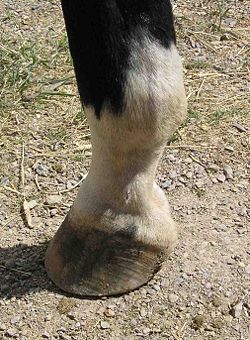|

Fetlock joint: the joint between the cannon bone and the pastern
"The fetlock joint is, arguably, the joint that makes a horse a horse," said Larry Bramlage, DVM, MS, Dipl. ACVS, a partner at Rood & Riddle Equine Hospital in Lexington, Ky., during the 2009 American Association of Equine Practitioners (AAEP) Convention held Dec. 5-9 in Las Vegas, Nev. "Its unique anatomy and physiology allow the high-speed, medium-distance activity that has led to the unique place for the horse in society, historically and currently ... The fetlock is a joint, a shock absorber, an energy storage system, and a stabilizer of the distal limb..." The Horse's Fetlock Joint: Injury, Disease, and Repair
Fetlock is the common name for the metacarpophalangeal and metatarsophalangeal joints (MCPJ and MTPJ) of horses... It is formed by the junction of the third metacarpal (forelimb) or metatarsal (hindlimb) bones (common name: the cannon bones) proximad and the proximal phalanx distad (common name: the pastern bone). Paired proximal sesamoid bones articulate with the palmar or plantar distal surface of the third metacarpal or metatarsal bones and are rigidly fixed to the proximo-palmar/plantar edge of the proximal phalanx.
The fetlock is a hinge joint (ginglymus), allowing flexion and extension, but minimal rotation, adduction, or abduction.
While sometimes the fetlock is colloquially referred to as an "ankle," even by horse experts, that terminology is not correct. The fetlock actually is a metacarpophalangeal joint which corresponds to the human upper knuckle, such as that on the ball of the foot.
Problems With the Fetlock
Windpuffs
Sesamoiditis
Osselet
Etymology and Related Terminology
The word fetlock literally means "foot-lock" and originally referred to the small tuft of hair situated on the rear of the fetlock joint. "Feather" refers to the particularly long, luxuriant hair growth over the lower leg and fetlock that is characteristic of certain breeds.
|